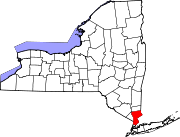
Westchester County is located in the U.S. state of New York. It is the seventh most populous county in the State of New York and the most populous north of New York City. According to the 2020 United States Census, the county had a population of 1,004,456, its highest decennial count ever and an increase of 55,344 (5.8%) from the 949,113 counted in 2010. Located in the Hudson Valley, Westchester covers an area of 450 square miles (1,200 km2), consisting of six cities, 19 towns, and 23 villages. Established in 1683, Westchester was named after the city of Chester, England. The county seat is the city of White Plains, while the most populous municipality in the county is the city of Yonkers, with 211,569 residents per the 2020 U.S. Census.

Bronxville is a village in Westchester County, New York, United States, located approximately 15 miles (24 km) north of Midtown Manhattan. It is part of the town of Eastchester. The village comprises one square mile (2.5 km2) of land in its entirety, approximately 20% of the town of Eastchester. As of the 2020 U.S. census, Bronxville had a population of 6,656. In 2016, Bronxville was rated by CNBC as the most expensive suburb of any of the U.S. ten largest cities, with a median home value of $2.33 million. It was ranked eighth in Bloomberg's "America's 100 Richest Places" in 2017 and 2018 and ninth in 2019 and is the second-richest town in the state of New York behind Scarsdale.
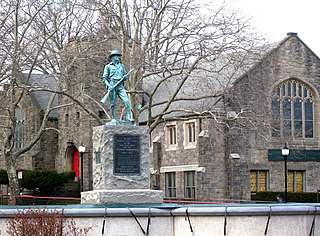
Mount Vernon is a city in Westchester County, New York, United States. It is an inner suburb of New York City, immediately to the north of the borough of the Bronx. As of the 2020 census, Mount Vernon had a population of 73,893, making it the eighth most populous city in the state (2020) and largest African American majority city in the state (2020).
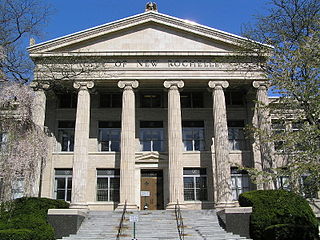
New Rochelle is a city in Westchester County, New York, United States, in the southeastern portion of the state. In 2020, the city had a population of 79,726, making it the 7th-largest city and 22nd-largest municipality in the state of New York. Some residents refer to the city as New Ro or New Roc City.

Tuckahoe is a village in Westchester County, New York, United States. One-and-a-half miles long and three-fourths of a mile wide, with the Bronx River serving as its western boundary, the Village of Tuckahoe is approximately sixteen miles north of midtown Manhattan in Southern Westchester County. As of the 2010 census, the village's population was 6,486.

Eastchester is a census-designated place (CDP) in Westchester County, New York, United States. The population was 19,554 at the 2010 census. The Eastchester CDP consists of the Town of Eastchester excluding the villages of Bronxville and Tuckahoe.

Pelham is a suburban town in Westchester County, approximately 10 miles northeast of Midtown Manhattan. As of the 2020 census, it had a population of 13,078, an increase from the 2010 census. Historically, Pelham was composed of five villages and became known as "the Pelhams". Pelham currently contains two independently incorporated villages: the Villages of Pelham and Pelham Manor.
Southern Westchester refers to the southern portion of Westchester County, New York, a dense inner-ring suburban area north of New York City.

The Hutchinson River, also known as Aqueanouncke in the Munsee language, is a 10 mile-long (16 km) freshwater stream located in the New York City borough of the Bronx and Southern Westchester County, New York, United States. It forms on the New Rochelle–Scarsdale municipal line off Brookline Road in the latter community and flows south, draining a 19.4-square-mile (50 km2) area. It continues to serve as New Rochelle's city line with Eastchester; further downstream; its lower reaches divide Mount Vernon and Pelham until it enters the Bronx and empties into Long Island Sound's Eastchester Bay.

Eastchester is a working-class neighborhood in the northeast Bronx in New York City. Its boundaries, starting from the north and moving clockwise are the Bronx-Westchester County border to the north, the New England Thruway to the east, Baychester Avenue to the south, and the intersection of 233rd Street and Baychester Avenue to the west. Boston Road is the primary thoroughfare through Eastchester and Dyre Avenue is the main commercial street. Eastchester includes the sub-neighborhood of Edenwald.

The Journal News is a newspaper in New York State serving the New York counties of Westchester, Rockland, and Putnam, a region known as the Lower Hudson Valley. It is owned by Gannett.
InTown Westchester is a regional lifestyle magazine that covers Westchester County, New York, and is published by Gannett and The Journal News. InTown was originally launched as a series of hyper-local editions targeting different regions of the county:
Westchester County, New York, in the United States, contains 40 public school districts, 118 private schools and 14 colleges/universities. According to the 2018 rankings provided by the education website Niche, taking into account public comments, 28 of the top 100 school districts in New York State were located in Westchester County.
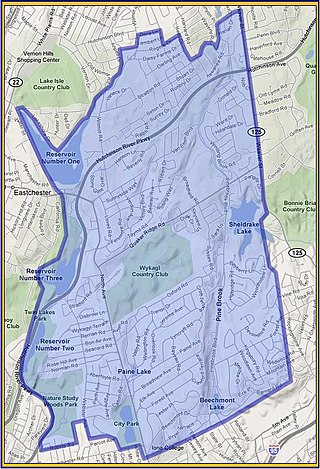
Wykagyl is a suburban community in New Rochelle, Westchester County, New York, United States. It is conterminous with ZIP code 10804, encompassing much of the city's 'North End'. According to Forbes, in 2010 Wykagyl's 10804 ZIP code, with a median home price of $806,264, ranked 333rd on its list of the 500 most expensive ZIP codes in the U.S. The Washington Post ranks Wykagyl among the nation's 650 Super Zips, or those with the highest percentile rankings for median household income and the share of adults with college degrees or higher.
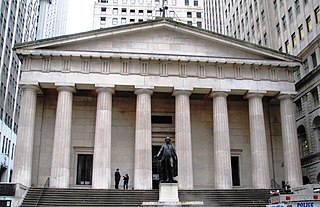
Tuckahoe marble is a type of marble found in southern New York state and western Connecticut. Part of the Inwood Formation of the Manhattan Prong, it dates from the Late Cambrian to the Early Ordovician ages. It was first quarried on a large scale commercially in the village of Tuckahoe, New York. Deposits are also found in the Inwood area of Manhattan, New York City, in Eastchester, New York, and extending southward to parts of the Bronx, such as Kingsbridge, Mott Haven, Melrose and Tremont and Marble Hill. Other locations in Westchester County include Ossining, Hastings, and Thornwood.
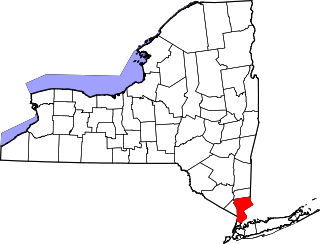
This is a list of the National Register of Historic Places listings in southern Westchester County, New York, excluding the cities of New Rochelle and Yonkers, which have separate lists of their own.
Cooper's Corners is a historic section of the city of New Rochelle in Westchester County, New York. For over two centuries Cooper's Corners served as an outpost for residents who lived in rural 'Upper New Rochelle', an area miles from the business center of town.

The Church of the Immaculate Conception is a Catholic parish church of the Archdiocese of New York located in Tuckahoe, New York. Founded in 1853, the parish is dedicated to the Immaculate Conception of the Blessed Virgin Mary. Following a merger, the parish was reorganized as the parish of the Immaculate Conception and the Assumption of Our Lady, including the respective two churches.

Eastchester Union Free School District is a school district headquartered in Eastchester, New York.


































